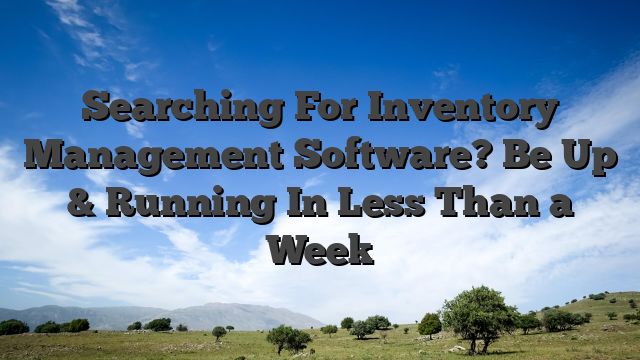In the fast-paced world of business, staying competitive often depends on how efficiently you manage your inventory. The right inventory management software can make all the difference, streamlining operations and ensuring that products are in the right place at the right time. In this blog, we’ll explore how you can find the perfect inventory management software and have your business up and running with it in less than a week.
The Need for Efficient Inventory Management
Efficient inventory management is the backbone of a successful business. It’s all about maintaining the right balance between having enough stock to meet customer demand and avoiding overstocking, which can lead to increased costs and tied-up capital.
Inefficient inventory management can result in issues like stockouts, missed sales opportunities, and increased carrying costs. The consequences are not just financial but can also impact your reputation and customer satisfaction. This is where inventory management software comes into play.
Why Inventory Management Software Matters
Inventory management software is designed to help you take control of your inventory, providing real-time visibility, automating processes, and optimizing stock levels. Whether you run a small online store or a large warehouse, the right software can save you time, reduce errors, and improve overall efficiency.
Here are some compelling reasons why inventory management software is essential:
- Real-Time Visibility: Stay updated on your inventory levels, no matter where you are. Real-time data helps you make informed decisions.
- Reduced Human Error: Manual data entry is prone to errors. Automation minimizes mistakes and streamlines processes.
- Cost Reduction: Avoid excess stock and minimize carrying costs, saving your business money.
- Improved Customer Satisfaction: Avoid stockouts and ensure that you can fulfill orders promptly.
- Optimized Stock Levels: Keep the right amount of stock on hand, ensuring you’re not tying up capital in excess inventory.
Finding the Right Inventory Management Software
Selecting the right inventory management software is a critical decision for your business. It’s essential to choose a solution that aligns with your specific needs and budget. Here’s a step-by-step guide to help you make the right choice:
Read More – Inventory management system for small business
1. Identify Your Needs
Begin by identifying your specific requirements. What challenges are you facing with your current inventory management process? Do you need features like barcode scanning, automated reordering, or multi-location support? Understanding your needs is the first step in finding the right software.
2. Set a Budget
Determine how much you’re willing to invest in inventory management software. Keep in mind that this is an investment that can lead to cost savings and efficiency improvements. Consider both the upfront cost and any ongoing subscription fees.
3. Research Options
There’s a wide variety of inventory management software available, from simple tools for small businesses to robust enterprise solutions. Conduct research and explore different options. Look for software that aligns with your needs, budget, and scalability requirements.
4. User-Friendly Interface
Choose software with a user-friendly interface. It should be intuitive and easy for your team to learn and use. A complicated interface can lead to resistance and errors.
5. Integration Capabilities
Consider whether the software can integrate with your existing systems, such as your e-commerce platform, accounting software, and point-of-sale systems. Seamless integration can streamline your operations.
6. Mobile Access
In today’s mobile world, having access to your inventory data on the go is essential. Ensure that the software provides mobile access and supports your preferred devices.
7. Support and Training
Check what kind of customer support and training options the software provider offers. Good support can be invaluable when you face issues or have questions about the software.
8. Scalability
Your business may grow, and your software should be able to scale with you. Consider whether the software can handle increased inventory and more complex operations.
9. Trial Period
Many software providers offer a trial period. Take advantage of this to test the software in your real-world scenarios. It’s an excellent way to ensure it meets your needs.
10. Reviews and References
Read reviews from other users and seek references from the software provider. Hearing about others’ experiences can provide valuable insights.
Quick Implementation: Be Up and Running in Less Than a Week
Once you’ve chosen the right inventory management software, the next step is implementation. Here’s a structured plan to help you get up and running in less than a week:
Day 1: Software Installation
Begin by installing the software on your chosen hardware. Ensure that it’s compatible with your operating systems and devices. Most modern inventory management software solutions offer cloud-based options, making installation hassle-free.
Day 2: Data Migration
If you’re transitioning from an existing system, migrate your data. This may include product information, stock levels, supplier details, and customer data. Data migration is a critical step to ensure continuity.
Day 3: Customization
Customize the software to match your specific needs. Configure settings, such as reorder points, preferred suppliers, and stock alerts. Tailoring the software to your business is essential for optimal performance.
Day 4: Training
On this day, provide training for your team. Ensure that they understand how to use the software effectively. Offer guidance on tasks like adding products, receiving stock, and creating purchase orders.
Day 5: Testing and Validation
Before going live, thoroughly test the software. Simulate real-world scenarios to validate its functionality. Check that inventory levels, stock alerts, and automated processes work as intended.
Day 6: Go Live
On the sixth day, it’s time to go live with your new inventory management software. Monitor operations closely, and be ready to address any issues promptly. Ensure that your team is comfortable using the software in their day-to-day tasks.
Day 7: Review and Fine-Tuning
After a week of operation, take time to review the software’s performance. Are there any issues or areas for improvement? Fine-tune settings as needed to optimize your workflow.
Continuous Improvement
Your journey with inventory management software doesn’t end on the seventh day. In fact, it’s just the beginning. Post-implementation, it’s essential to continuously monitor and improve your software’s performance. Regularly review key performance indicators (KPIs) related to your inventory, such as turnover rates, stockouts, and carrying costs. These metrics will help you assess the impact of your new system on your business.
Read More – Inventory management software company
As you move forward, keep the following in mind:
- User Feedback: Encourage your team to provide feedback on their experiences with the software. Their insights can help identify pain points and opportunities for improvement.
- Software Updates: Stay current with software updates and new features. Software providers often release updates to address issues, improve functionality, and enhance security.
- Scalability: As your business grows, ensure that your inventory management software can scale with you. You may need to add new features or integrations to support expanded operations.
- Training and Onboarding: If you hire new team members, be prepared to provide training and onboarding to get them up to speed with the software.
- Regular Audits: Conduct periodic audits of your inventory data to verify accuracy. This can help identify discrepancies and maintain data integrity.
- Compliance: Ensure that your software complies with any industry regulations or standards relevant to your business.
- Security Measures: As your inventory management system holds sensitive data, prioritize data security. Regularly update security measures to protect your business against potential threats.
Realizing the Benefits
Efficient inventory management has a significant impact on your bottom line. By implementing the right software and adhering to best practices, you can expect to see benefits such as reduced carrying costs, improved order fulfillment rates, enhanced customer satisfaction, and more efficient processes. Your inventory will be better aligned with customer demand, reducing the risk of overstock or stockouts.
Moreover, with better data visibility and automated processes, your team will be empowered to make informed decisions and focus on strategic tasks rather than manual data entry. This will ultimately lead to more productive and satisfied employees.
In summary, efficient inventory management is within your reach. Start by selecting the right software that aligns with your business’s needs and budget. With a well-planned implementation process, you can be up and running with your new software in less than a week. Continuous improvement and adaptation to changing business requirements will help you realize the long-term benefits of streamlined inventory management, ensuring the success and growth of your business.




